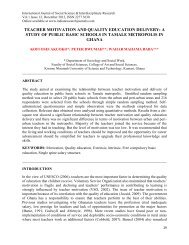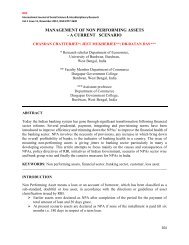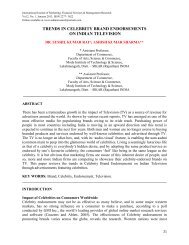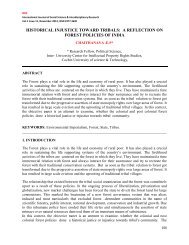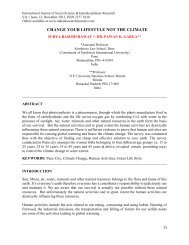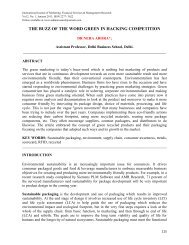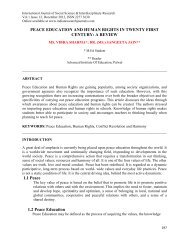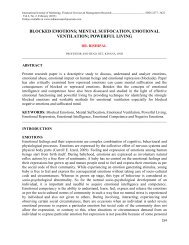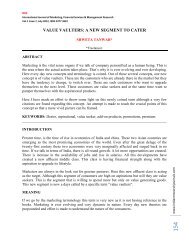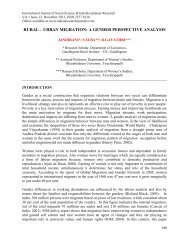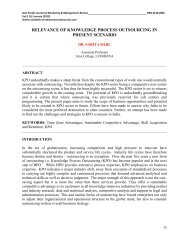regional rural banks in india and karnataka: a time series analysis
regional rural banks in india and karnataka: a time series analysis
regional rural banks in india and karnataka: a time series analysis
Create successful ePaper yourself
Turn your PDF publications into a flip-book with our unique Google optimized e-Paper software.
International Journal of Market<strong>in</strong>g, F<strong>in</strong>ancial Services & Management Research________________________ ISSN 2277- 3622<br />
Vol.2, No. 2, February (2013)<br />
Onl<strong>in</strong>e available at www.<strong>in</strong>dianresearchjournals.com<br />
Progress of the Regional Rural Banks <strong>in</strong> Karnataka:<br />
Agriculture <strong>and</strong> <strong>rural</strong> sector play an important role <strong>in</strong> India’s overall development. Regional<br />
Rural Banks (RRBs) were formed through RBI Act of 1976 to provide the credit to the <strong>rural</strong><br />
poor. RRBs were expected to evolve as specialized <strong>rural</strong> f<strong>in</strong>ancial <strong>in</strong>stitutions for develop<strong>in</strong>g the<br />
<strong>rural</strong> economy by provid<strong>in</strong>g credit to small <strong>and</strong> marg<strong>in</strong>al farmers, agricultural labourers, artisans<br />
<strong>and</strong> small entrepreneurs (Sardesai Committee, 2005). Dhananjaya (2005) <strong>in</strong> his paper stated that<br />
RRBs have played a key role <strong>in</strong> India <strong>in</strong> enhanc<strong>in</strong>g f<strong>in</strong>ancial services <strong>in</strong> <strong>rural</strong> areas. Apart from<br />
their focus on lend<strong>in</strong>g to the priority sector, these <strong>banks</strong> have also evolved different sav<strong>in</strong>gs<br />
products to provide safe sav<strong>in</strong>gs options <strong>in</strong> the <strong>rural</strong> areas. Over the years, RRBs emerged as a<br />
key <strong>rural</strong> f<strong>in</strong>ancial <strong>in</strong>stitutions <strong>in</strong> terms of geographical coverage, clientele outreach <strong>and</strong> bus<strong>in</strong>ess<br />
volume. From a modest beg<strong>in</strong>n<strong>in</strong>g of six RRBs with 17 branches cover<strong>in</strong>g 12 districts <strong>in</strong><br />
December 1975, the number of RRBs has grown <strong>in</strong>to 196 with 14,446 branches work<strong>in</strong>g <strong>in</strong> 518<br />
districts across the country <strong>in</strong> March 2004 (just before the amalgamation process). As on March<br />
2009, RRBs have a large branch network <strong>in</strong> the <strong>rural</strong> area form<strong>in</strong>g around 37 per cent of the total<br />
<strong>rural</strong> branches of Commercial Banks. The <strong>rural</strong> orientation of RRBs is evident from the fact that<br />
their <strong>rural</strong> <strong>and</strong> semi-urban branches constituted over 95 per cent of their branch network.<br />
Table-2 presents the performance of the RRBs <strong>in</strong> Karnataka State from the liberalization period<br />
i.e., 1990-91 to 2009-10. RRBs <strong>in</strong> Karnataka have achieved significant growth <strong>in</strong> terms of<br />
number of wide branches dur<strong>in</strong>g the both regimes. S<strong>in</strong>ce 1990-91 there were 13 RRBs with 1075<br />
branches work<strong>in</strong>g across the districts of Karnataka state. In addition to these compound growth<br />
rates were worked out to underst<strong>and</strong> the progress of the RRBs <strong>in</strong> Karnataka State, the highest<br />
growth rate could be observed <strong>in</strong> case of deposits constitut<strong>in</strong>g about 22.92 per cent compared to<br />
the Advances of the RRBs dur<strong>in</strong>g the liberalization regime. Dur<strong>in</strong>g the post liberalization regime<br />
the highest growth can be searched <strong>in</strong> case of Advances constitut<strong>in</strong>g about 20.29 per cent<br />
compared to the deposits. When the growth rate is observed it is the <strong>in</strong>crease of RRBs<br />
constitut<strong>in</strong>g about 20.39 per cent compared to the advances. In this manner s<strong>in</strong>ce from their<br />
<strong>in</strong>ception the RRBs have rendered services to the <strong>rural</strong> people <strong>and</strong> play an important role along<br />
with other f<strong>in</strong>ancial <strong>in</strong>stitutions.<br />
167



